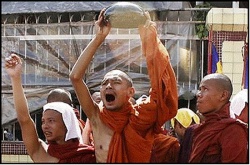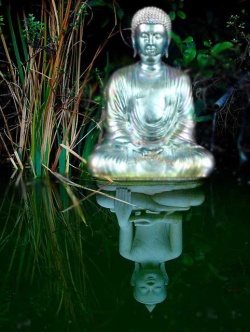The Dharmakaya and Emptiness
Today I will talk briefly about the dharmakaya. When you listen to teachings, you should generate the bodhicitta mind, the desire to obtain obtain Buddhahood for the sake of others.
This seems difficult, but whatever practice you do should be based on that attitude. Even though it seems a bit artificial, you should try to have that attitude.
If you do that, your practice will generate a great deal of virtue, because your practice will not be aimed for your own benefit. This is so even if the bodhicitta is not genuine.
Many people confuse loving kindness and compassion with bodhicitta. The attitude you should take is that first I will attain enlightenment so that I can lead all beings to enlightenment.
We all have buddha nature. It is our fundamental mind and is originally pure.
We have many different consciousness, such as the five sense consciousnesses and the sixth mental consciousness. These are like clouds in the sky covering our fundamental mind. Dharmakaya has two purities. Originally mind is pure. It is like gold that is hidden in the earth as ore. As we practice our negative thoughts will occur less and eventually they will be extinguished. When they are extinguished, that is the second purity. So one purity is by nature and one is through our efforts.
The two purities are called the svabhavivakaya. The wisdom is called jnanakaya. Their union is the dharmakaya. The purity and wisdom are inseparable in the dharmakaya. Dharmakaya always has wisdom. When the negativities are eliminated then our wisdom will manifest.
The dharmakaya cannot be spoken about or thought about, although here I am doing that. There are many great Indian and Tibetan scholars who have written down their understanding so we can have some idea of even though we haven't experienced it.
There are many analogies for dharmakaya. One is deep sleep without dreams. In the daytime we have many thoughts and activities.
But in dreamless sleep all of these are gone. Dharmakaya is beyond all conceptions.
Another analogy is the death state.
At the time of death the five elements dissolve. That state is close to the dharmakaya. Only the mental continuum remains. One goes through the stages of the white appearance, the red appearance, and the dark appearance and emerges in a state that resembles the dharmakaya.
Another analogy used is a finger pointing to the moon.
The various teachings are like a finger pointing to the moon. At the end of deity meditations, one dissolves the meditation into emptiness.
This is an attempt to approach the dharmakaya.
The sambhogakaya manifests from the dharmakaya. It is like the dreaming state. Even the highest level bodhisattvas cannot directly access the dharmakaya, but they can access the sambhogakaya and receive teachings from it. Ordinary beings cannot receive teachings from the bodhisattvas.
So the nirmanakaya manifests, like the Buddha being born in India. The nirmanakaya is like like the waking state.
At the time of death whatever deity you have practiced will appear to you in a dream. If you recognize the deity, you will not be reborn in the six samsaric realms. In the lower tantra you and the deity are separate and you beseech the deity. In the higher tantras there is no separation.
Q: The description you gave makes it sound like there is no consciousness at all in the dharmakaya.
A: No, the examples just give one side of the situation.
The dharmakaya is not nothingness. The Buddha can see all phenomena when resting in emptiness. The bodhisattvas do not see appearances when they are resting in emptiness, but they do see them when they are not resting in emptiness.
Q: Is the dharmakaya like the perfection of wisdom, the Prajnaparamita?
A: Yes .
Q: It seems impossible to use words to describe the dharmakaya.
A: There are twenty one wisdoms uncontaminated by thought in Buddhahood Thoughts are contaminated.
Q: Is there an experiencer of dharmakaya?
A: Yes, but it is not like ordinary experience.
Q: What is the the meaning of dharmakaya?
A: "Kaya" means source. Sometimes it's translated as body, but I don't think that's correct.
Emptiness is a very important subject in Buddhism. I just came from the Dalai Lama's teaching on emptiness. He gave the reading transmission of Nagarjuna's Seventy Verses and the Diamond Sutra.
And I would like pass on the reading transmission of Seventy Verses on to you. The reading transmission is like a blessing that increases your understanding. Afterwards I will talk a bit on emptiness.
This text is hard to explain because the terms in the text must first be defined. In India many Buddhist and non-Buddhist scholars held different views.
People asked Nagarjuna what he meant when he said everything was empty. He said our problem we create a true existence out of our mind where there is none. Grasping at this true existence is the cause of our problems.
Phenomena are like a hallucination and are not truly existent.
If you take them as real you are making a mistake which causes suffering. If you know that you will not attach to phenomena and that will make you more free.
Emptiness is taught to eliminate this misunderstanding.
So the purpose of teaching emptiness is to eliminate attachment. As attachment falls away and renunciation becomes stronger, one generates deeper compassion for all beings.
So what is the meaning of emptiness? Dependent origination. This is twofold, both causal and resultant dependent origination. Normally people accept the idea of cause and result.
But when the cause is present, the result cannot be. When a result is present, there is no cause. So the idea of cause and result is a mental projection.
It is an elaboration of mind. If someone is told they will be executed tomorrow, they will suffer. If their sentence is commuted to having their hand cut off, they will be happy.
This is an example of how mind creates reality and pain and suffering. If we think of the suffering of others, it is much greater than ours and our suffering doesn't seem so great.
Don't think of emptiness as nothingness. It means everything is dependently arisen. If you find something that did not depend on another, it would be real.
But things are not like that. Emptiness is the middle way between the beliefs of nothingness and true existence. Things exist, but in an illusory way.
It is like dreaming of an elephant in a small room. There is no elephant there in reality. It is like thinking a striped rope in a dark corner is a snake. When you understand emptiness you are released from many sufferings.
Some people say I don't want to study, just meditate.
But if you do this, you will just fall asleep. With understanding of emptiness, you will be alert in your meditation. In order to understand emptiness, you have to understand what is being refuted.
If you study the Dalai Lama's teaching on dependent origination, you will understand better.
Chokyi Goecha Susquehana Yoga October 20, 2007




